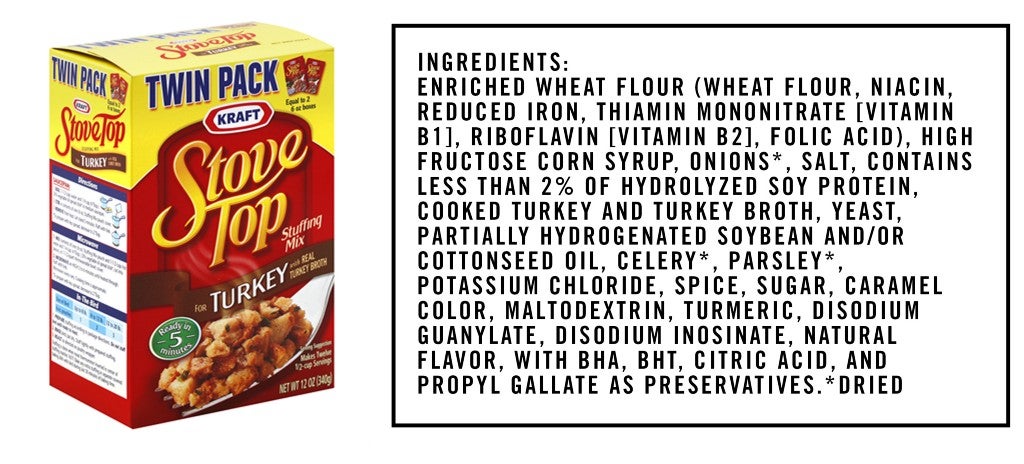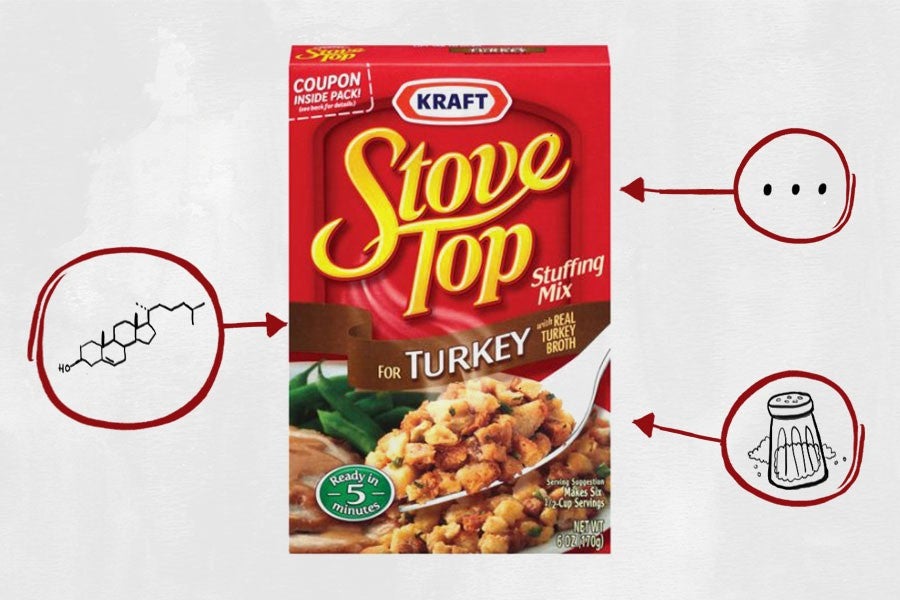We’re often told that you should never eat anything (or put anything on your body) if you don’t recognize everything on the ingredients list. But since most of us have no idea what xanthan gum or potassium benzoate are — or more importantly, what they’re doing to our bodies — we’re decoding the ingredients in the many things Americans put in (and on) themselves with the help of an expert.
This edition: Kraft Turkey Stuffing Mix, which is made from 23 separate ingredients that we’ve broken down in the exact order they appear on their website.

The Ingredients
1) Enriched Wheat Flour (Wheat Flour, Niacin, Reduced Iron, Thiamin, Mononitrate [Vitamin B1], Riboflavin [Vitamin B2], Folic Acid): As we learned in our exploration of the many, many, many ingredients in the McDonald’s Big Mac, enriched flour isn’t actually “enriched” at all. Not only does it contain more calories than whole wheat flour, but the bleaching process enriched flour undergoes produces an unfortunate byproduct: a chemical called alloxan, which has been found to induce diabetes in lab-animal test subjects by destroying their pancreas.
2) High Fructose Corn Syrup: High fructose corn syrup is corn syrup that has had some of its glucose converted to fructose enzymatically. It’s a commonly used sweetener, and has been linked to obesity and diabetes by many, many studies. So, if possible, you want to avoid foods containing this ingredient.
3) Dried Onions: These are added as flavoring.
4) Salt: More flavoring.
5) Hydrolyzed Soy Protein: This ingredient is a flavor enhancer produced by boiling soy in hydrochloric acid, then neutralizing the solution with sodium hydroxide. The result is pure amino acids, which are often used to give processed foods a fuller flavor, similar to the way MSG is used.
6) Cooked Turkey and Turkey Broth: The quintessential turkey flavor.
7) Yeast: The fungus that makes dough rise.
8) Partially Hydrogenated Soybean and/or Cottonseed Oil: According to physician and biochemist Cate Shanahan, author of Deep Nutrition: Why Your Genes Need Traditional Food, consuming too much vegetable oil — which is easy to do, considering Shanahan previously told us roughly 45 percent of the average American’s calories come from refined oils — has serious repercussions (e.g., fatty liver disease, insulin resistance and migraines). But hydrogenated vegetable oil is even worse: When you add hydrogen to food via hydrogenation — which many manufactures do to increase the food’s shelf life — you get trans fats. Unfortunately, trans fats raise cholesterol, harden arteries and inhibit the formation of an enzyme called cyclooxygenase, which helps determine the dilation of your arteries and regulates blood flow.
While it’s nearly impossible to eliminate vegetable oil from your diet altogether — major contributors include processed foods, fried foods, frozen pizzas, cakes, cookies, margarines and coffee creamers — it’s best consumed in moderation.
9) Dried Celery: Again, added flavoring.
10) Dried Parsley: Surprise! Also added flavoring.
11) Potassium Chloride: Potassium chloride is added to food for two reasons: 1) To act as a salt substitute; and 2) to enhance the amount of potassium — an essential and widely under-consumed nutrient — found in the product. While small amounts — like that found in this stuffing — shouldn’t do you any harm, nutritionist David Friedman, author of Food Sanity: How to Eat in a World of Fads and Fiction, warns of consuming too much of the stuff. “Potassium chloride is used to induce cardiac arrest during executions by lethal injections,” he says. “That should speak volumes as to whether this ingredient belongs in our food supply.” Dagan Xavier, ingredient expert and co-founder of Label Insight, says you shouldn’t worry too much, though: “Potassium Chloride has a very bitter taste, and therefore, overuse is unlikely within our food supply.”
12) Spice: As we learned in our exploration of the ingredients in nacho-flavored Doritos, the FDA doesn’t require food labelers to list each spice by their specific name (as a means of protecting their recipes) so long as it follows their definition of the word “spice”:
The term spice means any aromatic vegetable substance in the whole, broken or ground form, except for those substances which have been traditionally regarded as foods, such as onions, garlic and celery; whose significant function in food is seasoning rather than nutritional; that is true to name; and from which no portion of any volatile oil or other flavoring principle has been removed.
13) Sugar: In addition to adding sweetness (obviously), sugar reduces the time it takes for dough to rise, which is important when making bread-based stuffing.
14) Caramel Color: As in our exploration of the eight ingredients that make up Diet Coke, caramel coloring has an incredibly controversial byproduct called 4-methylimidazole (4-MEI). A 2007 study found that mice fed a diet of 4-MEI developed cancerous lung tumors as a result. The FDA quickly pushed back, noting that a human would have to consume more than 1,000 cans of soft drinks (which are notoriously high in caramel coloring) every day for two years to reach comparable levels of 4-MEI.
Who’s right is still unclear. More recent studies argue that levels of 4-MEI are, in fact, high enough in soda and consumed in sufficient quantities by Americans to increase the risk of developing cancer.
Now, do you really have to worry about this in your few scoops of stuffing? Probably not.
15) Maltodextrin: An artificial sugar made from maltose (aka malt sugar) and dextrose (a sugar derived from starches), maltodextrin is usually used as a thickener or filler ingredient to add bulk to processed food and to increase its shelf life. (Maltodextrin itself has a shelf life of two years.)
16) Turmeric: Flavoring and possibly a coloring agent.
17) Disodium Guanylate: Used in conjunction with MSG and disodium inosinate (see below), disodium guanylate has a savory taste that essentially allows manufacturers to increase the flavor of food without loading it with sodium. The risk of consuming too much of this stuff is more or less the same as MSG — i.e., headaches and nausea. Again, though, Shanahan previously told us there’s no reason to worry about these flavor enhancers as long as you consume them alongside some kind of protein — like, say, a slab of turkey — to quell those negative effects.
18) Disodium Inosinate: A savory flavor enhancer that’s almost always used in conjunction with MSG and disodium guanylate. It’s a purine, meaning it’s one of the building blocks of DNA, and thus, it’s often derived from animal origin like beef, pork, poultry and fish. So if you’re a vegetarian or a vegan, be sure to avoid products containing disodium inosinate.
19) Natural Flavor: Natural flavors are quite literally flavors derived from an actual food source — i.e., turkey flavoring taken from a real turkey.
20) BHA: Butylated hydroxyanisole (aka BHA) is a common preservative added to prevent products from spoiling. “In lower levels — like those found in foods — some researchers consider BHA to be perfectly safe,” Friedman explains. “On the flip side, the National Toxicology Program has concluded that BHA ‘is reasonably anticipated to be a human carcinogen.’” Generally speaking, BHA is probably worth avoiding as best you can.
21) BHT: Butylated hydroxytoluene (aka BHT) is another common preservative added to prevent products from spoiling. Studies continue to go back and forth about whether or not it’s carcinogenic, so it’s hard to say whether the minuscule amounts found in this boxed stuffing would cause you any harm.
22) Citric Acid: Citric acid naturally occurs in citrus fruits; it’s often added to foods to extend their shelf life.
23) Propyl Gallate: Often used in conjunction with BHA and BHT, propyl gallate is another preservative. Animal studies found that it’s “slightly toxic” when ingested.
The Takeaway
Kraft’s Turkey Stuffing Mix is “stuffed” with potentially dangerous ingredients — partially hydrogenated vegetable oils, potassium chloride and BHA, chief among them. When considering if the fact that some of these ingredients might be carcinogenic should be enough to make you avoid this stuffing altogether, Friedman argues thusly: “There’s no organic, plant-based food on the market that could be cancer causing,” he emphasizes. “Stick with nature, and you’ll never go wrong.”

